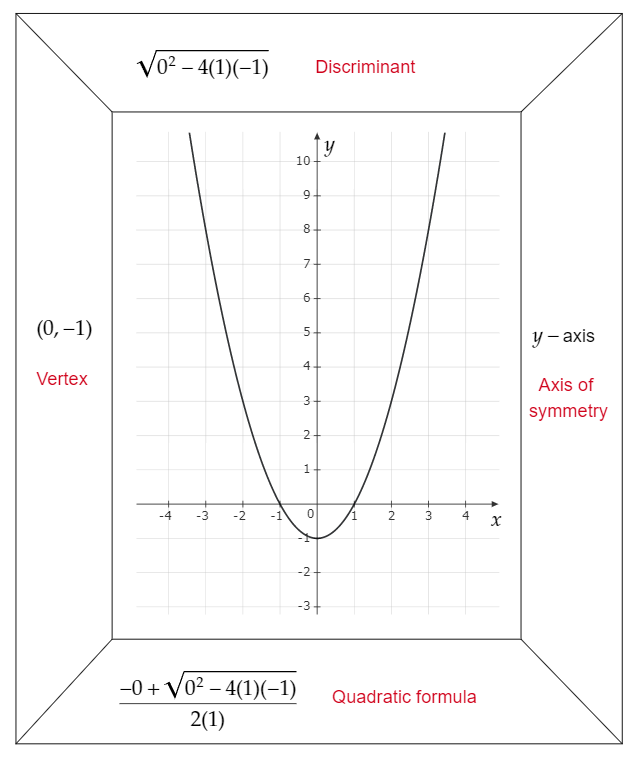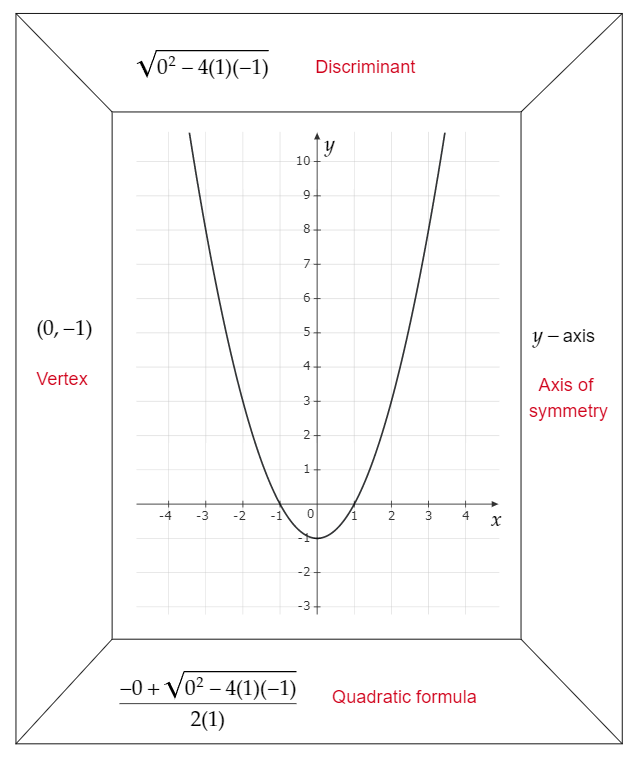Algebra 2 Volume 1 1st Edition Unit 2 Quadratic Functions, Equations, And Relations Page 110 Problem 1 Answer
A figure containing five sections is given, where the middle section includes the graph of a quadratic function, and the remaining four sections contain some information.
Also, a few ✓ words are given in the question.
The question requires to complete the graphic by placing one suitable ✓ word in each of the four sections of the frame surrounding the graph.
To complete the graphic, observe the expressions and words written in each of the surrounding four sections, use the given graph of a quadratic function, and the formulas for discriminant and quadratic formula to choose a suitable word to be placed in each of the four sections.
Then, write the suitable words in the sections and thus, complete the graphic.
The top section of the frame includes the expression √02−4(1)(−1).
This expression is in the form √b2−4ac, that is the root of the discriminant.
Thus, the suitable word to be written in the top section of the frame is ‘discriminant’.
The bottom section of the frame includes the expression −0±√02−4(1)(−1)/2(1).
This expression is in the form −b±√b2−4ac/2a, that is the right-hand side of the quadratic formula x=−b±√b2/−4ac/2a.
Thus, the suitable word to be written in the bottom section of the frame is ‘quadratic formula’.
The left section of the frame includes the point (0,−1).
From the graph, it can be observed that the point (0,−1)is the vertex of the graph of the function.
Thus, the suitable word to be written in the left section of the frame is ‘vertex’.
The right section of the frame includes the term y-axis.

From the graph, it can be observed that the graph of the function is symmetrical about the y-axis.
Thus, the suitable word to be written in the right section of the frame is ‘axis of symmetry’.
Write the suitable words in the respective sections in the given frame to complete the graphic.
The required completed graphic is:

HMH Algebra 2 Volume 1 Unit 2 Quadratic Functions Overview
HMH Algebra 2 Volume 1 1st Edition Unit 2 Quadratic Functions, Equations, And Relations Page 110 Problem 2 Answer
A parabola is a curve where every point lying on the parabola is equidistant from a fixed line and a fixed point.
The fixed line and the fixed point are respectively called the directrix of the parabola, and the focus of the parabola.
Therefore, every point on a parabola is equidistant from a fixed line, called the directrix, and a fixed point, called the focus.
Every point on a parabola is equidistant from a fixed line, called the directrix, and a fixed point, called the focus.

HMH Algebra 2 Unit 2 Quadratic Equations Solutions
HMH Algebra 2 Volume 1 1st Edition Unit 2 Quadratic Functions, Equations, And Relations Page 110 Problem 3 Answer
A number which is not real is called a complex number.Every complex number is in the form a+bi, where i=√−1.
Here, a and bare called the real and imaginary part of the complex number.
Therefore, a complex number is any number that can be written as a+bi, where a and b are real numbers and i=√−1.
A complex number is any number that can be written as a+bi, where a and bare real numbers and i=√−1.
HMH Algebra 2 Unit 2 Quadratic Functions And Relations Key
HMH Algebra 2 Volume 1 1st Edition Unit 2 Quadratic Functions, Equations, And Relations Page 110 Problem 4 Answer
A matrix is a set of numbers that are arranged in rows and columns.
The arrangement of the numbers in the rows and columns forms a rectangle.
This rectangle formed by the arrangement is a rectangular array.
Therefore, a matrix is a rectangular array of numbers.
The vocabulary term required to complete the statement is ‘matrix’ because a matrix is a rectangular array of numbers.
So the final answer is: A matrix is a rectangular array of numbers.
